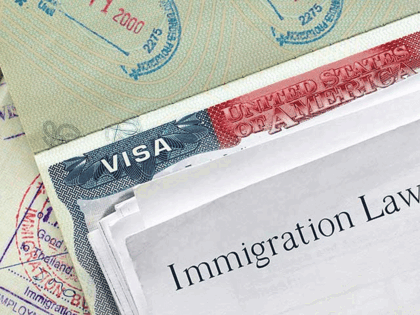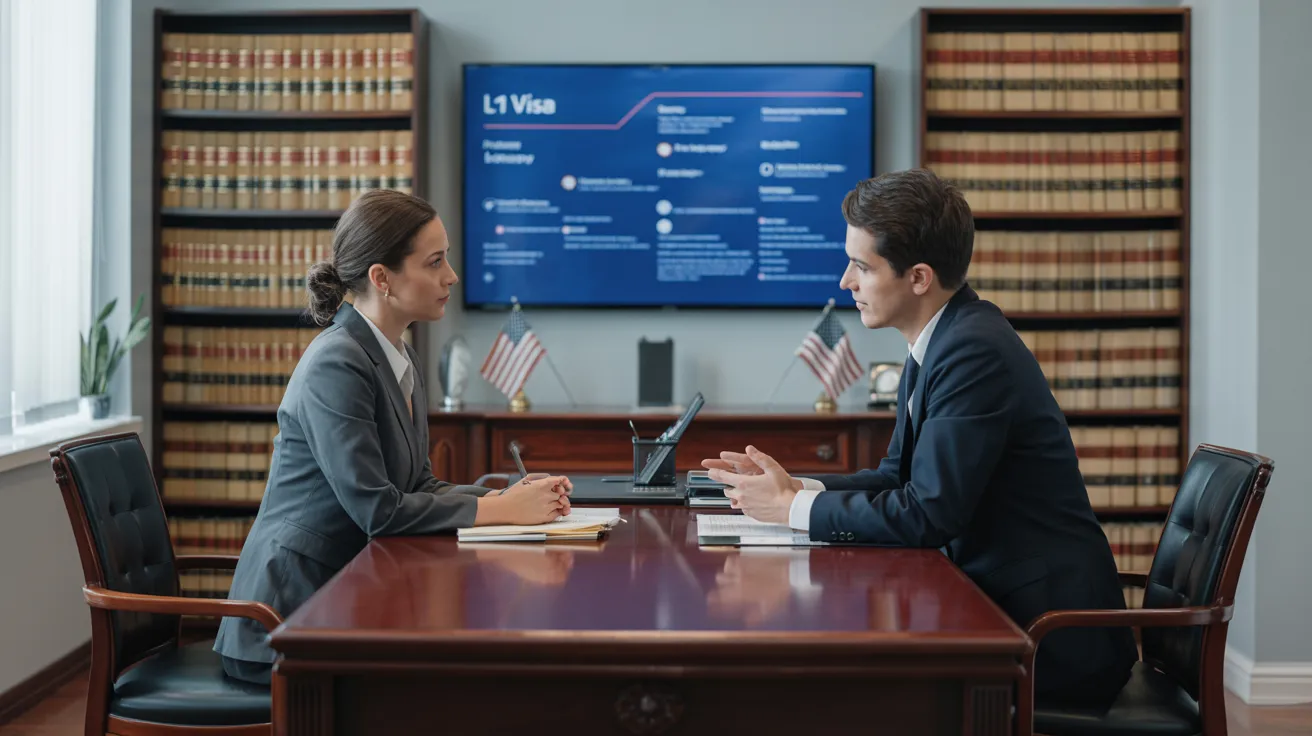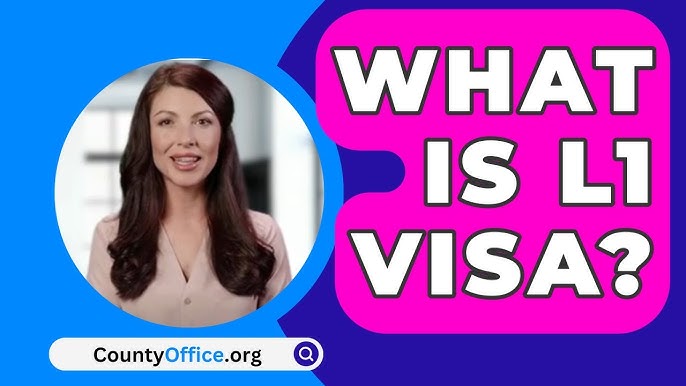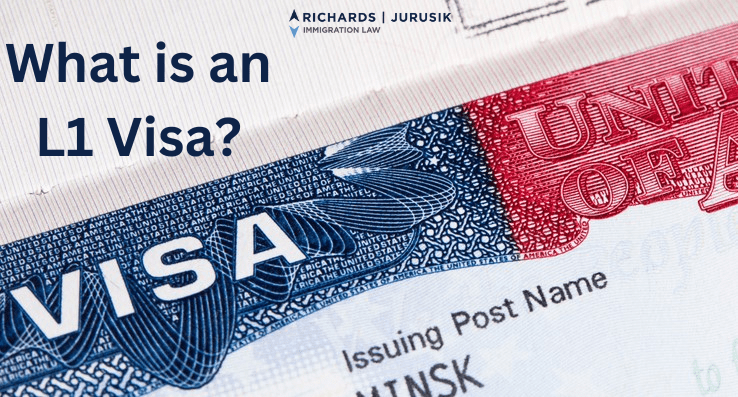Unlocking Opportunities: A Comprehensive Overview to the L1 Visa Process
The L1 visa procedure presents a critical pathway for international companies seeking to move essential workers throughout boundaries. Recognizing the subtleties of qualification standards, the distinctions in between L-1A and L-1B visas, and the complexities of the application procedure can greatly impact an applicant's success. Nevertheless, maneuvering this complex landscape is not without its challenges, and mindful interest to documentation and company sponsorship is necessary. As we explore the vital parts of this process, the techniques for conquering possible barriers will come to be noticeable, disclosing exactly how notified prep work can open a globe of chances.
Recognizing the L1 Visa
Understanding the L1 visa entails identifying its significance as an essential device for multinational business looking for to move experienced employees between global offices. This non-immigrant visa classification assists in the activity of executives, supervisors, and specialized knowledge workers to the USA, thereby allowing companies to maintain operational continuity and harness worldwide talent efficiently. The L1 visa is split right into 2 main categories: L-1A for managers and execs, and L-1B for employees possessing specialized knowledge.The L1 visa offers a crucial role in enhancing a business's one-upmanship in the worldwide marketplace - L1 Visa Requirements. By enabling companies to move their essential personnel, businesses can ensure that crucial projects are managed by certified people that are already accustomed to the company's society and functional processes. This interior transfer system not only fosters understanding sharing however also promotes innovation and collaboration across borders.Moreover, the L1 visa is often favored for its fairly simple application process compared to various other visa classifications, as it enables double intent, permitting holders to seek irreversible residency while on a temporary copyright. This function makes the L1 visa especially appealing for both employers and staff members, as it simplifies the path for competent experts to develop long-term residency in the USA
Qualification Requirements
Qualification for the L1 visa depends upon several vital criteria that assure both the employee and the employer satisfy particular credentials. This non-immigrant visa is created for multinational firms to move employees from international workplaces to U.S. counterparts.Firstly, the company must be a qualifying organization, that includes a moms and dad business, branch, affiliate, or subsidiary of an U.S. service. The firm must have been doing organization for at the very least one year both in the U.S. and abroad. This ensures that the company has enough functional security and a reputable presence.Secondly, the staff member must hold a managerial, executive, or specialized knowledge position. For L1A visas, the applicant has to show managerial or executive certifications, while L1B visas concentrate on specialized understanding pertaining to the organization's products, solutions, or procedures. Additionally, the employee must have helped the international entity for at the very least one continual year within the last three years before their application.Lastly, the worker's function in the U.S. need to align with their previous setting, making certain that their skills and experience are leveraged for the firm's advantage.
Kinds Of L1 Visas
The L1 visa classification comprises 2 main types created to help with the transfer of employees within international business: the L1A visa for supervisors and execs, and the L1B visa for workers with specialized knowledge. Each type offers distinct objectives and has particular qualification criteria.The L1A visa is tailored for people that hold managerial or executive placements within a business. This visa allows top-level workers to move to a united state branch, subsidiary, or associate of the exact same organization. Applicants for the L1A visa must show that they have actually been utilized in a supervisory or executive capacity for a minimum of one continual year within the past 3 years before their application. In addition, this visa uses a much longer duration of keep, originally granted for three years, with the opportunity of expansions for up to seven years.In comparison, the L1B visa is meant for professionals with specialized understanding pertaining to the company's items, services, or processes. To qualify, applicants must prove that their know-how is critical to the organization which they have benefited at the very least one continuous year within the last 3 years in a role that required this specialized understanding. The L1B visa is initially given for three years, with extensions readily available for approximately 5 years.Both visa types are necessary for firms seeking to boost their international operations by leveraging competent personnel, consequently promoting innovation and effectiveness within the united state market.
Application Process
Guiding with the L1 copyright procedure entails several important actions that need to be meticulously complied with to assure a successful outcome. The process begins with the united state employer, who must initially establish qualification by demonstrating a qualifying relationship with the international entity and validating that the staff member meets the certain requirements for the L1 visa group being sought.Once qualification is verified, the employer initiates the process by submitting Kind I-129, the Petition for a Nonimmigrant Employee, with the United State Citizenship and Immigration Provider (USCIS) This kind must be gone along with by an in-depth summary of the job responsibilities to be performed, the organizational framework of both the U.S. and international entities, and the employee's qualifications. It's crucial to confirm that all information is exact and complete, as noninclusions or mistakes can bring about hold-ups or denials.Upon approval of the I-129 petition, the following step involves the worker making an application for the L1 visa at an U.S. embassy or consular office in their home country. This phase requires the conclusion of Form DS-160, the Online Nonimmigrant copyright, and arranging a meeting. Throughout the meeting, the applicant has to provide evidence sustaining their credentials and the employer's petition.After the visa is given, the employee can go into the United States to work in the marked role. Generally, mindful preparation and adherence to each step of the application procedure are crucial for a successful L1 visa outcome.
Needed Documents

Vital Types Required
Maneuvering the L1 Visa procedure calls for cautious focus to the crucial forms and documents essential for a successful application. The main form needed is the Type I-129, Petition for a Nonimmigrant Employee, which should be completed and submitted by the U.S. employer. This kind lays out the information of the work offer and the credentials of the employee seeking the L1 Visa.Alongside Type I-129, the candidate will require to full Kind I-539 if going along with relative are additionally obtaining visas. Furthermore, the company must give evidence of the certifying relationship between the U.S. entity and the international entity, usually requiring the entry of corporate records such as short articles of unification or financial statements.Moreover, it is necessary to include the L Classification Supplement to Form I-129, which defines the kind of L Visa being asked for-- either L-1A for supervisors and executives or L-1B for employees with specialized understanding. Candidates need to assure that all types are authorized and dated appropriately, as insufficient entries can lead to hold-ups or rejections. Correctly putting together these important types lays the structure for a smoother L1 copyright procedure.

Sustaining Evidence Needs
Sustaining documentation is vital for a successful L1 copyright, as it confirms the cases made in the application. Candidates must provide a variety of documents to demonstrate qualification for the visa, which is classified right into 2 key types: evidence of the certifying connection in between the U.S. and international entities and evidence of the candidate's qualifications.To develop the partnership, candidates need to submit paperwork such as business organizational charts, economic declarations, and proof of possession. These records confirm that the international business has a qualifying relationship with the united state employer, whether as a moms and dad company, subsidiary, branch, or affiliate.For the candidate's credentials, crucial papers consist of a comprehensive work letter from the foreign company, describing the candidate's work title, tasks, and duration of employment. Furthermore, educational credentials, such as levels and diplomas, must be offered to prove the candidate's proficiency in the pertinent field.
Company Sponsorship Documents

Common Obstacles
Navigating the L1 visa process offers a number of common obstacles that applicants should recognize. Key concerns frequently include rigid paperwork needs, possible hold-ups in handling times, and the necessity for rigorous legal compliance. Understanding these challenges can aid applicants better prepare and alleviate risks during their copyright trip.
Documentation Needs
The L1 copyright procedure usually provides substantial difficulties connected to documentation needs. Applicants should supply extensive paperwork to establish qualification, which can bring about confusion and possible hold-ups. Key files include evidence of a qualifying partnership in between the U.S. and international employer, evidence of the candidate's employment background, and comprehensive info regarding the job function in the U.S.One typical obstacle is collecting adequate proof to demonstrate the nature of the qualifying relationship. Business typically have a hard time to present clear organizational graphes or economic statements that illustrate the link in between the entities. In enhancement, guaranteeing that letters of assistance from employers properly mirror the candidate's work obligations and certifications is important, as vague descriptions can lead to denials.Another issue arises from the need for in-depth work summaries that line up with the L1 visa categories. Candidates should verbalize not only their existing function however also their supervisory or specific understanding obligations plainly. This necessitates a complete understanding of both the applicant's position and the governing language used in L1 applications.
Handling Time Delays
Experiencing hold-ups in processing times is a typical difficulty faced by L1 visa candidates, frequently leading to irritation and unpredictability. A number of elements contribute to these hold-ups, consisting of high application quantities, boosted scrutiny of applications, and management backlogs within the united state Citizenship and Migration Services (USCIS) Candidates might find that processing times can vary considerably depending on the solution facility managing their application, as each center has its very own workload and performance levels. Additionally, the complexity of the applicant's case, such as the demand for considerable documents or clarification, can better prolong wait times.In some circumstances, issues associated with the applicant's existing immigration condition or previous visa background may likewise result in extra hold-ups, as USCIS may need additional testimonial or info. It is vital for prospects to remain positive during this duration, maintaining open interaction with their employers and legal reps to address any potential worries promptly.Understanding these handling time obstacles can assist L1 visa applicants prepare for possible hold-ups and minimize the influence on their change and job strategies. Patience and diligence are essential virtues in maneuvering this complex procedure.
Legal Compliance Issues
Numerous L1 visa candidates run into lawful conformity concerns that can complicate their journey toward getting the visa. Comprehending and adhering to the specific regulations established by the united state Citizenship and Migration Services (USCIS) is important. Common challenges include demonstrating the qualifying relationship between the foreign and united state companies, along with confirming that the candidate has the requisite specialized understanding or managerial capacity.Additionally, applicants must give thorough documents detailing their job responsibilities, business structure, and economic viability of the U.S. entity. Poor or incorrect paperwork can lead to delays or perhaps rejections. Companies should also assure that they follow labor laws, including wage and working condition criteria, which can impact visa eligibility.Another common concern includes maintaining compliance with the terms of the visa once provided. Adjustments in employment status, task responsibilities, or firm structure can require amendments to the visa, which otherwise attended to quickly can lead to lawful difficulties. As an outcome, remaining notified concerning conformity needs and seeking lawful guidance when needed is crucial to navigate the intricacies of the L1 visa process effectively.
Tips for Success
Success in the L1 copyright process often hinges on thorough prep work and interest to detail. To enhance your opportunities of approval, begin by completely comprehending the qualification requirements for both the L1A and L1B visa classifications. Examine whether your position at the firm certifies as managerial, exec, or specialized understanding, as this classification especially affects your application.Next, collect comprehensive paperwork that substantiates your insurance claims. This consists of organizational charts, detailed task summaries, and evidence of the company's operational structure. Clear and concise proof of the certifying relationship between the united state entity and the foreign entity is essential. Verify that all files are arranged realistically and provided in a specialist fashion, as this shows your dedication and severity concerning the application.Engage the solutions of a seasoned migration attorney who concentrates on L1 visas. Their expertise can show important, assisting you via facility guidelines and assuring that all documentation abides by current laws. Additionally, plan for the meeting by exercising solution to usual inquiries and being all set to review your duty and payments to the business in deepness.
Often Asked Inquiries
Can Family Members Accompany the L1 Visa Holder?
Yes, member of the family of L1 visa holders, consisting of partners and unmarried children under 21, can come with the key visa holder. They may also apply for L2 visas, which enable them to live in the United States.
How Much Time Can I Remain On an L1 Visa?
The L1 visa permits first remains of as much as three years, with the opportunity of expansion. L1A visa holders may stay for an optimum of 7 years, while L1B visa owners can stay for 5 years.
Can L1 Visa Owners Get an Environment-friendly Card?
Yes, L1 visa owners can request a permit. L1 Visa. They may seek irreversible residency with employment-based categories, typically requiring sponsorship from their company, provided they fulfill the needed qualifications and documents requirements
What Takes place if My L1 copyright Is Denied?
If your L1 copyright is refuted, you may receive a notice describing the reasons for denial. You can look for to appeal the decision, reapply, or discover alternate visa choices based upon your conditions.
Are There Any Traveling Limitations With an L1 Visa?
An L1 visa generally enables worldwide traveling; nevertheless, re-entry to the U. L1 Visa.S. rests upon maintaining legitimate condition. Travelers must assure compliance with visa problems to prevent complications upon return
Verdict
